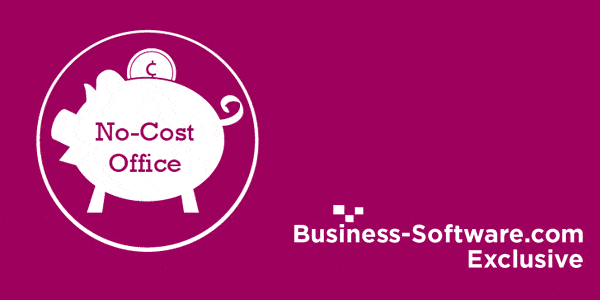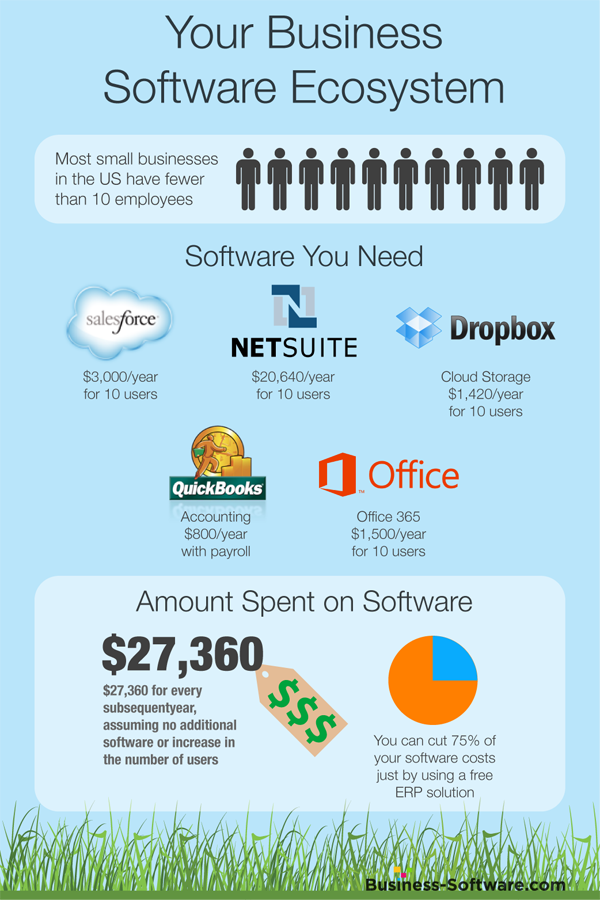The No-Cost Office, Part 1: Our Guide to Finding Free Software Solutions for your Business

Welcome to The No-Cost Office, a Business-Software.com exclusive series on how to build your business’ software suite for free. Every week we’ll tackle a new software segment and compare the best available free solutions to help you build up your arsenal of business tools without breaking the bank.
Say you’re starting your own business – nothing big right now, just you and a few employees. You’ve got a great product and you’re all excited to get started – now it’s time for a couple tools to help keep you organized. First you get a small business accounting program – Quickbooks Essentials should do the trick, with Payroll thrown in to make sure your loyal employees get paid on time. That’s $65.95/month. Then you get Salesforce – one of the more basic plans, only $25/user/month- but that adds up to $250/month for your team of ten. And you’ll need data storage, so you upgrade your Dropbox account to Dropbox Pro, at a whopping $499 per year for 500GB of storage. You’re already spending over $4300 on software this year, and you haven’t even started searching for tools for contract management, a CMS for your website, or an inventory management system to keep track of your stock. There’s no avoiding it – enterprise grade software can get expensive, pricing out many smaller companies who already have scant profit margins.
As your business grows, it becomes necessary to take advantage of any number of the multitude of software solutions available to help you manage data, optimize business processes and scale your business successfully. Unfortunately, many enterprise-grade software solutions are prohibitively expensive, especially for young companies with tight budgets. But relegating your business management to an Excel spreadsheet or even pen and paper can lead to any number of errors, and tends to be time consuming. By finding free software solutions to meet their small business needs, savvy business owners can gain valuable insight into their data and spend time and energy developing their products and services rather than constantly performing routine management tasks.
What is Free Software?
Many business software vendors offer a free trial version of their product, which can be a valuable offer if you’re ready to commit to using a potentially expensive program after your 30 day trial is up. Truly free software is a little harder to come by, but are indispensable tools for smaller businesses with strict budgets. There are two major types of free software, Open Source and Freemium versions.
Open Source solutions are solutions which the developer has opted to make the code public and downloadable for anyone. Open source solutions tend to be extremely flexible and customizable, giving users the freedom to take the software in whatever direction fits their business model best. However, open source solutions tend to require some degree of technological proficiency, so they aren’t always the best option for beginners.
Freemium Versions of paid software are are solutions offered by software developers who offer a free basic version of their paid software. “Freemium” software solutions tend to be stripped down, simplified versions of the paid, enterprise-grade solutions. While they’re usually mean to entice free users into upgrading to the paid edition, freemium solutions often work well in their own right as well, especially for SMBs. While these “lite” versions aren’t usually as flexible or as powerful as open source software, they are great solutions for small companies with basic needs, and users who plan to upgrade to a more powerful solution after some amount of time.
Is the Free Software Route Right for You?
If your company is growing rapidly, then trying to cobble together a free office might not be a feasible option. But for small companies, free editions can be a great way to get the benefits of a software designed to streamline your business processes and management, without incurring huge costs associated with many software providers. It’s important to keep in mind that free software users don’t always have the strong support network that paying customers do, so the users that get the most out of free editions are usually self-starters or people with some degree of tech proficiency from the beginning.
Get started by reading the first post in this series, Free Accounting Software Solutions for Savings that Add Up. Check out the rest of the No-Cost Office series on the Business-Software.com blog.






